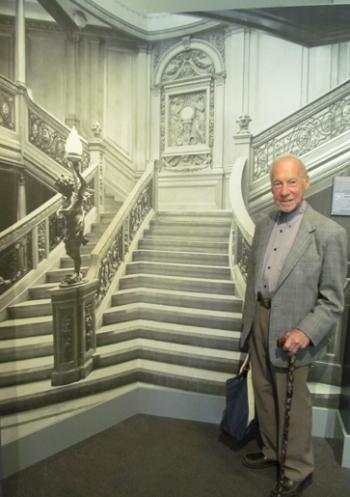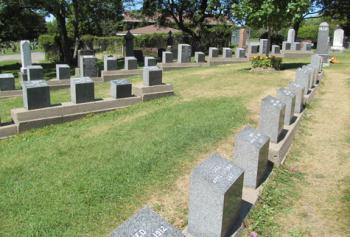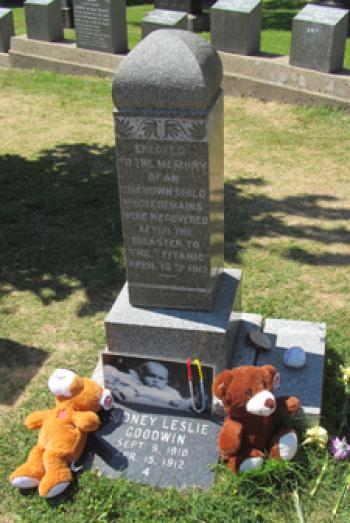Halifax and the Titanic
This item appears on page 52 of the June 2018 issue.
Ask anyone what the greatest disaster at sea is that they can think of and almost invariably the answer will be “the sinking of the Titanic.”
Shortly before midnight on April 14, 1912, the Titanic, on her maiden voyage from Europe to New York, struck an iceberg and sank within three hours early on the morning of April 15. Only 705 survived. More than 1,500 died in the cold waters of the North Atlantic.
My husband, Paul, and I flew to Halifax, Nova Scotia, in August 2017 to join an Atlantic Tours group visiting three of Canada’s eastern provinces: Nova Scotia, Prince Edward Island and Newfoundland & Labrador.
We arrived four days in advance of the tour’s starting date because we wanted to explore Halifax on our own. Halifax has a unique connection to the Titanic, and I had become fascinated with everything relating to the fate of this ship.
Recovery of Titanic victims
In 1912 the White Star Line, which operated the Titanic, had an agent working in Halifax. Halifax was only about 700 nautical miles (about 800 land miles) from where the Titanic went down.
The White Star Line hired a number of Halifax-based vessels to scour the site of the ship’s sinking to recover as many bodies as possible. They and other ships recovered 337 bodies.
There is disagreement about how many were brought back to Halifax and how many were buried at sea. Probably more than 200 were brought to Halifax, many of whom were claimed by relatives for burial elsewhere. One hundred fifty remained in Halifax and were buried in three of the city’s cemeteries.
Along with the bodies, floating debris from the Titanic was also recovered, some of it kept by crew members of the Halifax recovery ships as mementos of the tragedy. Some of this debris was later donated to Halifax’s Maritime Museum of the Atlantic. We made the museum our first port of call in Halifax.
Maritime museum
The Maritime Museum of the Atlantic (902/424-7490, maritime museum.novascotia.ca), located in the vibrant waterfront area of the city, houses an assortment of artifacts from the Titanic, including the only known surviving Titanic deck chair, a life jacket, a mortuary bag that once held items found on a Titanic victim’s body (as bodies were recovered, each was assigned a number and an accompanying bag with the same number to hold items found on the body), fragments of ornate wood paneling and molding and — most poignantly — a pair of shoes belonging to a young child.
Although the Titanic exhibit is the prime draw in the museum for most visitors, including me, almost as interesting is an exhibit commemorating the 100th anniversary of the Halifax Explosion of 1917. Two vessels collided in Halifax harbor, detonating tons of high explosives that killed almost 2,000 Haligonians and injured 9,000 more — a horrendous event in the city’s history.
The Maritime Museum of the Atlantic is located at 1675 Lower Water Street. It’s open 9:30 to 8 Tuesday, 9:30 to 5 Wednesday to Saturday and 1 to 5 Sunday and is closed on Monday. Admission costs CAD9.55 (about $7.50) from May to October and less from November to April.
Fairview Lawn Cemetery
One hundred fifty Titanic victims lie buried in three Halifax cemeteries: 121 in Fairview Lawn Cemetery, 19 in Mount Olivet Cemetery (Roman Catholic) and 10 in Baron de Hirsch Cemetery (Jewish). We decided to visit the cemetery where most of the victims rest, Fairview Lawn (902/490-4883, www.titanicmemorials.co.uk/post/memorial/fairview+lawn+cemetery+Halifax).
It is a moving experience to be there. Simple grave markers indicate where each body lies. There are 79 identified by name; 42 remain nameless. Each of them — even those who have been identified — has a number on their tombstone indicating the order in which they were retrieved from the sea by the recovery vessels. All markers bear the same date: April 15, 1912.
There’s one gravestone that stands out. It belongs to the fourth victim recovered, a young boy. His identity remained uncertain for 99 years. In April 2011, DNA tests finally proved that this young victim was 19-month-old Sidney Goodwin, whose parents and five siblings also perished in the disaster. When we visited, his grave had two small teddy bears next to it — a remembrance even after 105 years.
A woman visiting Fairview Lawn Cemetery pointed out to me that if one stands at a particular spot, two lines of grave markers converge to form the shape of a ship’s bow, surely not an accidental alignment.
Fairview Lawn Cemetery, located at 3720 Windsor Street, can most easily be reached from downtown Halifax by taxi in 15 minutes, but be sure to ask the taxi to wait for you while you visit.
The cemetery is open to visitors from 8 to 4, Monday through Friday.
Five Fishermen Restaurant
Our final port of call was the Five Fishermen Restaurant (1740 Argyle St.; 902/422-4421, www.fivefishermen.com), considered one of the best in Halifax. Back in the spring of 1912, this was the location of Snow & Company Funeral Home, where many of the Titanic victims were taken before burial. None of the restaurant personnel felt inclined to discuss the restaurant’s famous though lugubrious past or the ghosts that diners occasionally report seeing.
The restaurant is open for dinner daily from 4 to 10 p.m. Our dinner there cost the two of us CAD170 (about $132) and included appetizers, main courses, predinner drinks, coffees and tip. Reservations are recommended.
More Titanic sites
For those interested in more sites associated with the Titanic, there’s a book sold in the Maritime Museum of the Atlantic, “Titanic Remembered” by Alan Ruffman, that includes a list and a map of 21 sites linked in some way with the Titanic.
Among them are Halifax churches where memorial services were held in 1912 as well as the still-existing homes of several Haligonians who were passengers aboard the doomed ship.
If you go…
In August 2017, we toured Halifax on our own because a tour we took with Atlantic Tours (Dartmouth, Nova Scotia; 800/565-7173, www.atlantictours.com), “East Coast Islands” (May ’18, pg. 52), did not include sightseeing in Halifax although our tour began in Halifax. Other Atlantic Tours trips do include sightseeing in Halifax. Atlantic Tours can arrange for Halifax sightseeing as an addition if it’s not included on the tour you book.
Allow at least two or three nights for Halifax if it’s not already included in the tour you’ve booked. Four or five nights is better.
We found lots of things to see and do. Our favorites — strolling the extensive waterfront area, meandering in and out of shops and stopping at cafés and restaurants; exploring the Halifax Citadel (a National Historic Site of Canada), a large fortress originally built in the mid-18th century atop the city’s highest hill, and viewing the colorful “primitive” paintings of Nova Scotia native Maude Lewis in the Art Gallery of Nova Scotia.
And, of course, all the Titanic-related sites/sights.



